|
Report from
Europe
Record start to the year for UK tropical imports
The import value of tropical wood and wood furniture into
the UK in the opening two months of this year were at
record levels. In the January to February period, import
value totalled US$270 million, 47% more than the same
period in 2021 when imports were also high following a
strong rebound after the downturn during the first COVID
lockdown in 2020.
In fact, this was by far the highest value import of tropical
wood and wood furniture products into the UK in any two
month period since at least before the 2008 financial
crises.
The strong performance in the first three months of this
year reflect both high consumption in the UK, still
supported by post-COVID government stimulus, and the
late arrival of delayed shipments from the previous year.
Demand has remained particularly good in housing repair,
maintenance, and improvement, always a big driver of
hardwood demand and the fastest growing part of the UK
construction sector following the initial COVID lockdown.
Meanwhile, the availability of hardwood and furniture
products from the UK's traditionally largest suppliers in
Europe and the United States was very tight even before
Russia's invasion of Ukraine in the last week of February,
encouraging importers to look more to tropical products.
Importers also tend to thrive when prices are high and
margins wide, so there has been a strong incentive to look
around for supplies and build stock.

The high level of UK import value in the opening months
of the year is also partly owing to high material prices and
freight costs. Although hardwood product prices were
declining steadily from the middle of last year to February
this year, they are still very high compared to the
beginning of last year. Freight rates also declined from the
heights reached in the third quarter of last year but were
still at a historically very high level at the end of February.
The downward trend in hardwood prices has reversed
since Russia¡¯s invasion of Ukraine. This event seriously
disrupted all supplies of European and Russian hardwood
products, partly because of the direct effects of sanctions
against Russia, partly the immediate effects of the war on
Ukrainian supply, and partly because of the large numbers
of Ukrainians, who contribute a disproportionately large
number of truck drivers operating in Europe, who returned
home during the conflict.
The war has also driven up energy costs, filtering through
into rising prices for all European manufactured products,
including for wood and furniture.
According to statistics provided by the UK Department for
Business, Energy & Industrial Strategy (BEIS), timber
prices in the UK have been significantly affected by the
war in Ukraine. The price of sawn or planed wood
imported into the UK increased on average by 2.5% in
March this year following five months of steady decline.
The price was also 11% more than in March 2021. The
price of imported plywood also increased 2.5% in March
this year and was up 28% compared to March 2021.
Less positive outlook for UK market in 2022 and 2023
Prospects for strong demand for wood products in the UK
continuing this year and into 2023 look increasingly
uncertain. In early May the Bank of England warned that
Britain¡¯s economy could plunge into recession before the
end of this year.
The gloomy outlook statement came as the Bank¡¯s
monetary policy committee (MPC) raised interest rates
from 0.75% to 1% to tackle spiralling inflation made
worse by Russia¡¯s war in Ukraine and the impact on
supply chains from COVID lockdowns in China. With a
fresh jump in UK home energy bills expected in October,
when a government-imposed cap on energy charges is due
to be removed, it forecast inflation would rise above 10%
this year, the highest level since 1982.
Squeezed between rising borrowing costs and high levels
of inflation, the Bank said that British households this year
are likely to suffer the second biggest squeeze on their
incomes since records began in 1964.
Economists at the Resolution Foundation said the Bank¡¯s
projections showed the average household in Britain
would lose about £1,200 this year from the cost of living
squeeze, laying the ground for a weaker period of growth
ahead as families rein in their spending.
The pound fell sharply after the rate decision as the City
reacted to Britain¡¯s weaker economic prospects. Sterling
tumbled by almost 3 cents against the dollar on the
currency markets and by more than a cent against the euro.
The MPC said the sharp rise in energy costs projected in
October this year would likely result in a fall in GDP in
the fourth quarter. Although a modest recovery is expected
at the start of next year, ensuring two consecutive quarters
of falling GDP (the technical definition of a recession) is
likely to be avoided, the Bank warned Britain¡¯s economy
would shrink by 0.25% over the course of 2023 as a
whole, in effect a slow-burn recession.
Reflecting this uncertainty in the wider economy, the UK
Construction Products Association (CPA) sees a dramatic
slowing in growth in its latest forecast published in early
May.
In previous years, the predicted 2.8% growth in
construction output anticipated by the CPA team would be
cause for celebration. However, while a robust figure, this
is a sharp revision down from the 4.3% growth forecast
just three months ago.
According to CPA, demand has continued to be strong
across the UK construction industry in the second quarter,
and the current project pipeline suggests that this will
support activity levels until at least the third quarter of this
year. The downward revision to the growth forecast stems
from concern around a host of price pressures arising from
both local and global issues.
Prior to the conflict in Ukraine, UK construction was
already facing labour and product availability issues due to
disruption during COVID pandemic and effects of Brexit.
Rising energy costs were driving near-record price
increases in construction products and the conflict has
exacerbated this issue, according to CPA.
Across all sectors of UK construction, the picture is one of
positive market conditions in the short term with
anticipation of tougher times ahead. Conditions are
expected to be particularly volatile in the private housing
repair, maintenance, and improvement sector. While
booming at present, this is the sector arguably most
exposed to current price inflation, falls in consumer
confidence and pressures on household incomes. Overall,
CPA expects output in this sector to fall by 3% in 2022
and 4% next year from current all-time highs.
Private housing, the largest construction sector in the UK,
remains strong, with housebuilders reporting resilient
demand. Longer term, there must be questions over
consumer confidence but CPA forecasts output in this
sector to rise by 1% in both 2022 and 2023.
This contrasts with the 3% per year growth forecast three
months ago.
The fastest growth is expected in the industrial sector, in
which output is forecast to rise by 9.8% in 2022 and 9.3%
in 2023, due to a strong pipeline of warehouse projects,
resulting from a long-term shift towards online shopping.
Indonesia leads rise in tropical wooden furniture
imports into the UK
Overall the UK imported US$136 million of tropical wood
furniture products in the first two months of 2022, which
is 29% more than the same period in 2021. It is also 23%
more than the same period in 2020, before trade was
affected by the first COVID lockdown which began in the
UK on 23 March 2020.
UK imports of wooden furniture from all four of the
leading tropical supply countries were very strong in the
opening two months of this year compared to last year
including Vietnam (+27% to US$66 million), Malaysia
(+28% to US$28 million), Indonesia (+103% to US$17
million) and India (+71% to USS16 million).
Imports from Singapore, which increased sharply last year
due to shipping problems elsewhere in Southeast Asia, fell
back 57% to more a "normal" level of just US$3 million in
the two month period (Chart 2).
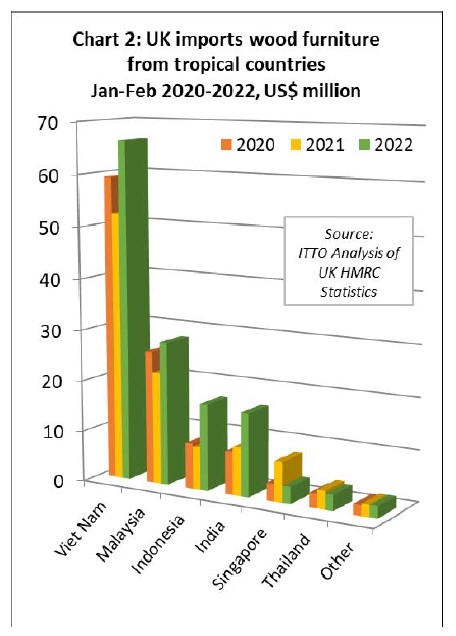
UK tropical wood imports up 72% in the first two
months of 2022
UK imports of all tropical wood products in Chapter 44 of
the Harmonised System (HS) of product codes were
US$134 million in the first two months of 2022, 72%
more than the same period in 2021 and 81% up on the
(pre-COVID) level in the same period in 2020.

Compared to the first two months last year, UK imports of
tropical joinery products increased 64% to US$53 million,
imports of tropical plywood were up 46% to US$32
million, imports of tropical sawnwood were up 132% to
US$28 million, and imports of tropical mouldings/decking
increased 71% to US$6 million (Chart 3 above).
After the sharp dip in UK imports of tropical joinery
products during the first lockdown period in the second
quarter of 2020, imports of this commodity group have
progressively built momentum.
This trend is mainly driven by Indonesia for which UK
joinery imports, mainly consisting of doors, were US$28
million in the first two months this year, 44% more than
the same period in 2021 and 108% more than the pre-
COVID level in the first two months of 2020 (Chart 4).
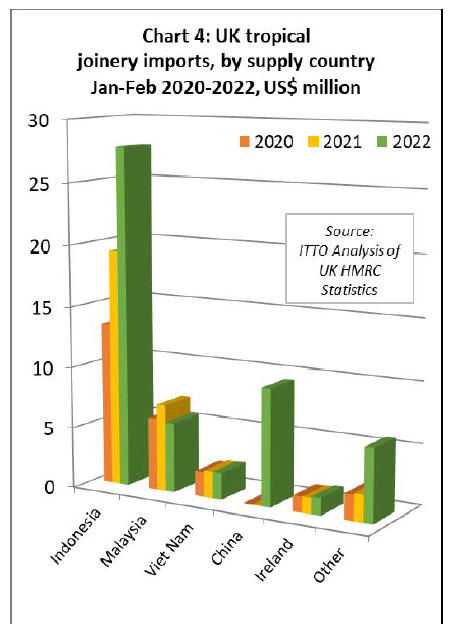
UK imports of joinery products from Malaysia and
Vietnam (mainly laminated products for kitchen and
window applications) started this year more slowly.
Imports from Malaysia were US$6 million in the two
month period, 20% less than the same period last year.
Imports of US$2 million from Vietnam in the first two
months this year were the same level as last year.
UK import value of Chinese joinery products, nearly all
comprising doors, was US$10 million in the first two
months of 2022, up from negligible levels in previous
years. Due to introduction from 1st January 2022 of new
product codes in the EU Combined Nomenclature (still
mirrored by the UK post-Brexit) it is now possible to
identify wood doors and windows manufactured using a
wider range of tropical wood species in UK and EU trade
statistics.
The apparent rise in imports of "tropical" wood joinery
from China is very likely due to these products now being
identifiable as of tropical species, whereas previously they
were classified as "other non-coniferous" in the trade
statistics and excluded from the figures for tropical wood
imports.
In the first two months of 2022, the UK imported 20,900
tonnes of tropical hardwood plywood, 3% less than the
same period last year and 9% down on the same period in
2020. Imports from the UK¡¯s three largest suppliers of
tropical hardwood plywood ¨C Indonesia, Malaysia, and
China ¨C have followed very different trajectories in recent
years (Chart 5).
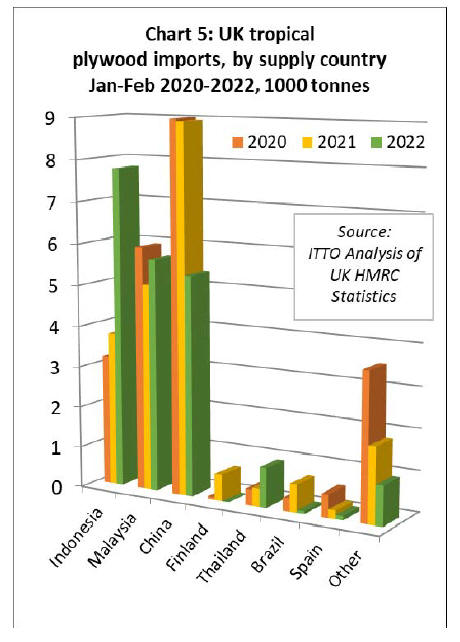
UK imports of tropical plywood from Indonesia were
7,800 tonnes in the first 2 months of this year, a gain of
107% compared to the same period last year and 144%
more than the pre-pandemic level in the first two months
of 2020.
This suggests a potentially significant shift towards
Indonesia in the UK plywood sector, all the more
remarkable because it was occurring before economic
sanctions against Russia, imposed from March onwards,
effectively removed Russian birch plywood from the UK
and wider EU supply equation.
The likelihood is that the UK will have to turn more to
Indonesia for hardwood plywood supply in the future, if
only Indonesian exporters are able, or willing given
potentially strong demand elsewhere, to make sufficient
volumes available to the UK market.
However, too much shouldn't be read into just two months
of data, particularly when logistical challenges and high
container rates have led to more dependence on less
frequent breakbulk shipments into the UK from Indonesia.
In contrast to the very large gains in UK imports of
plywood from Indonesia in the first two months of 2022,
imports of 5,700 tonnes from Malaysia were just 12%
more than the same period last year and 5% less than the
same period in 2020. UK tropical hardwood plywood
imports from China started this year even more slowly, at
5,300 tonnes in the first two months, down 40% on the
same period in 2021 and 41% less than this period in
2020.
Big shift in countries supplying tropical sawnwood to
the UK
UK imports of tropical sawnwood started this year
strongly. Imports were 15,800 tonnes in the first two
months of 2022, 72% more than the same period last year
and 32% more than the same period in 2020.
In addition to making major gains overall, there were big
changes in the countries supplying tropical sawnwood to
the UK in the opening months of this year (Chart 6). This
is indicative of the major shifts in hardwood markets since
the start of the pandemic which have led to significant
supply shortages and sharply increasing prices in many
supply regions along with continuing high levels of
demand in markets like the UK.
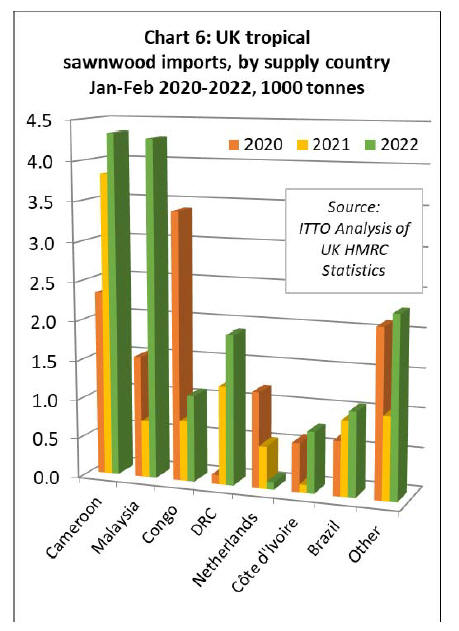
UK imports of tropical sawnwood from Cameroon were
4,300 tonnes in the first two months of this year, 13%
more than the relatively high level in the same period last
year and 86% more than the same period in 2020.
UK imports from Malaysia, which had fallen to little more
than a trickle in recent years, were 4,300 tonnes in the first
two months this year, a 5-fold increase compared to the
same period last year and nearly a 3-fold gain compared to
the pre-pandemic level in the opening two months of
2020.
In contrast, UK imports of tropical sawnwood from the
Republic of Congo (RoC) were only 1,100 tonnes in the
first two months of this year which, while 43% more than
the same period last year, were 68% less than the same
period in 2020. Before the pandemic, the UK had been
sourcing more sawn hardwood from RoC but this trend
has faltered in the last two years.
However, there has been a big rise in UK imports from
DRC, which were 1,900 tonnes in the first two months this
year, a gain of 52% compared to the same period last year.
UK imports from DRC were negligible before the
pandemic.
UK imports of tropical sawnwood from Côte d'Ivoire were
800 tonnes in the first two months this year, a big increase
compared to negligible imports in the same period last
year and a 25% increase compared to the same period
before the pandemic in 2020.
Imports of tropical hardwood sawnwood from Brazil also
made gains from a small base, at 1,100 tonnes in the first
two months of this year, 13% more than the same period
last and 55% more than the same period in 2020.
Indirect UK imports of tropical sawnwood from other EU
countries have fallen dramatically since the UK¡¯s
departure from the EU single market on 1st January 2021.
Total UK imports from EU countries were 2,600 tonnes in
the first two months of this year, 30% less than the same
period last year and 39% down on the same period in
2020.
UK imports of tropical hardwood mouldings/decking were
relatively high in the opening two months of 2022, at 2000
tonnes, 88% more than the same period the previous year
and 90% more than the pre-pandemic level in the first two
months of 2020.
This is another commodity group for which there has been
particularly strong demand in the UK, combined with
sharply tightening supply since the start of the pandemic.
And like in the plywood sector, the war in Ukraine and
sanctions on Russia are expected to lead to even tighter
supplies of non-tropical decking products that directly
compete with tropical decking in the short to medium
term.
UK imports of decking/mouldings increased sharply from
Indonesia and Brazil in the first two months of this year.
Imports of 751 tonnes from Indonesia were 230% more
than the same period last year and 108% more than the
same period in 2020. Imports of 490 tonnes from Brazil
were 149% up on the same period in 2021 and 71% more
than the same period in 2020.
Imports from Ghana, at 117 tonnes in the first two months
of this year, while still very small were potentially
significant for representing the first notable increase in
imports of this commodity from Ghana for several years.
(Chart 7).
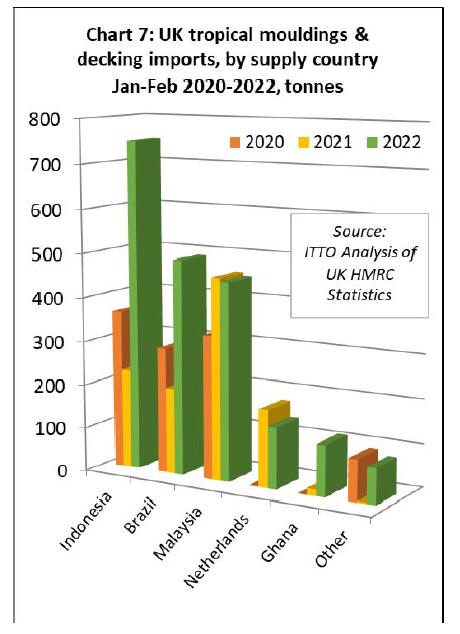
|